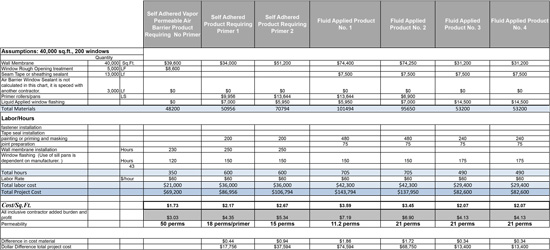Breaking Old Rules for Air-Barrier Installation
Questions to Ask when Specifying an Envelope Membrane System
To determine the best membrane for the building envelope, the architect, designer, or specifier should ask these questions:
When choosing between self-adhered WRB/air barrier, peel-and-stick with primer, and fluid-applied barriers, what are the installed costs and total time in labor to complete the task? When costing out a wall assembly, considering just the cost of the materials and not the labor cost for installation results in an inaccurate estimate. To accurately estimate the cost of the assembly, both the material and the labor should be considered. This should include the time needed to prep the sheathing to receive the barrier. Here is an example:
Is extensive field training necessary to install the product? Increasingly, as skilled labor shortages affect the industry, installation errors tend to increase. Specifying a complicated, difficult-to-install product could lead to installation errors and increase failures, and thus risk. Ideally, the product should require minimal contractor field training.
How is the product affected by the weather? Unless the project is in San Diego, California, or in a mild Mediterranean climate, there will be weather. That means, for most of the country, times of rain and freezing weather. If the WRB/air barrier cannot be installed in freezing temperatures, the project could well shut down until the weather improves. The cost of a shutdown could be exorbitant and will certainly be disruptive to the remainder of the construction schedule. Ideally, the product can be installed in freezing temperatures.
Is the membrane UV stable? This question should be asked for several reasons. It should be a concern if there is a possibility of construction delays. If there are, and the membrane is exposed for an extended time before the cladding installation, the membrane will be at risk of degradation from UV damage. It’s important to note how long the membrane can be exposed. Also, if there are exposed gaps in the sheathing, the membrane behind it should have superior UV performance.
What is the perm or drying rate? The most effective vapor-permeable, self-adhering air-barrier membrane will have the highest drying capacity. As the permeance increases, so does the drying capacity.
In terms of sequencing, when can WRB/air barriers be installed? Can the WRB/air barriers be installed before or after the roof? When walls are dry? The flexibility of the material to fit into the building schedule could have massive impact on the job.
What is the compatibility with other materials? This is the emerging issue with new products that come on the market. While the material itself might perform well, it needs to be compatible with the substrate and cladding. Check to see if the barrier is compatible with the most common substrates:
• Exterior gypsum
• Rigid insulation
• Precast concrete
• Concrete block
• Cast-in-place concrete
• Plywood
• Pre-painted steel
• Galvanized metal
• Aluminum (painted, mill)
• Anodized aluminum
• Rigid vinyl
The exterior cladding must also be considered. Many buildings use multiple types of cladding to create a certain architectural visual appeal, so for ease of installation and construction schedule, a single WRB/air barrier should perform behind multiple types of cladding.
Wall PreparationFor proper installation of the self-adhered WRB/air-barrier membrane, all surfaces must be dry, sound, clean, and free of oil, grease, dirt, excess mortar, or other contaminants detrimental to the adhesion of the water-resistive air-barrier membrane and flashings. Trades workers should fill voids and gaps in substrate greater than 7/8 inch in width to provide an even surface.
Plus, a self-adhered WRB/air barrier (it’s not actually required, but highly desirable because the drainage plane allows the water somewhere to leave the structure) requires a ventilated, unimpeded vertical drainage cavity or rainscreen system to be incorporated into all WRB/air-barrier installations. It’s likely the membrane manufacturer offers compatible and corresponding accessories to accomplish this, as well as flashing materials for window and door rough openings, and flashing materials for transitions.
LimitationsWhile most self-adhered, water-resistive, vapor-permeable air-barrier sheet membrane are quite durable, there are some general and practical limitations. Many carry recommendations to be installed in temperatures no lower than 20 degrees Fahrenheit. Contamination of the wall and building site will adversely affect the membrane’s water resistance. Many of these membranes should not be subjected to asphaltic materials, chemicals, surfactants, or cleaning compounds that could affect the water resistance of the membrane surface; if exposed, replace affected membrane.










